St. Brigid's Catholic Church
cnr Livingstone and Marrickville Roads, Marrickville
Henry Bryceson 1865, rebuilt S.T. Noad & Son 1957 (3/36 electro-pneumatic)
Restored Darrell Pitchford 2020


Photos: Trevor Bunning (Dec 2008)
From SOJ December 1965, June/July 1981, June/July 1994
St. Brigid's is one of the largest and most beautiful Catholic churches in Sydney. Its large tower, like that of St. Clement's Anglican Church, Marrickville, can be seen for some distance. The organ was built in 1865 by Henry Bryceson of London for an unknown location in England and was later installed in ''Bomerah", residence of the brothers McQuade, Potts Point. It was moved in 1921 to St. Brigid's where it was rebuilt by S.T. Noad & Son in 1957. The instrument was originally operated by tracker action, but this was removed so that the case could be divided on either side of a rose window with a centrally placed detached console. Despite the alterations which have taken place, the instrument has mostly retained its original specification, and the voicing has not been changed. The organ speaks in an excellent acoustic.
Click here to download an MP3 (3.2MB) of Michael Dudman playing the Gigout Scherzo
The organ has the following stoplist:
| Great Double Bass Open Diapason Gamba Salicional Harmonic Flute Principal Twelfth Fifteenth Trumpet Swell Double Diapason Open Diapason Viol de Orchestra Lieblich Gedact Keraulphon Flute Principal Mixture Vox Humana Oboe Cornopean Choir Rohr Flute Echo Dulciana Gamba Voix Celeste Gamba Gedackt Flute Gemshorn Cor Anglais Clarinet Pedal Open Metal Open Wood Bourdon Bass Flute Violone Gemshorn Trombone |
16 8 8 8 4 4 2-2/3 2 8 16 8 8 8 8 4 4 II 8 8 8 8 8 8 8 4 4 2 8 8 16 16 16 8 8 4 16 |
A A |
Electro-pneumatic action
15 couplers
The following three artices are taken from the Sydney Organ Journal, Spring 2020:
1953: the Marrickville Bryceson before the rebuild
William Pierce
This church situated in Marrickville Road seats just under two thousand people. It is a large, lofty building with a semi-circular roof. This may account for the considerable sound reverberation period which greatly enhances the organ tone. The instrument, which is situated on the northern side of the western gallery, is a three-manual organ of thirty-nine speaking stops built in 1865.
According to Father Stanislaus, priest-in-charge of the music at St. Brigid’s, the organ early in the present century belonged to a Mr. McQuade, a theatrical entrepreneur. It is believed that McQuade bought the organ second-hand in England and had it installed in a specially constructed room in his home at Darling Point. In 1915, the Sydney piano firm of Rendall added a pedal Trombone 16′ and a set of chimes. About 1920, the organ was purchased for the present church at a cost of £1,500. It was re-erected here by C. Richardson but the Pedal Trombone and set of chimes were not connected.
With the exception of the Pedal stops and the lowest octave of the Swell Double Diapason, the organ is tracker action. The casework consists of pipes from the metal open 16′ and the Great Open Diapason 8′. The mechanical condition of the organ is very poor. While the key action operates satisfactorily enough, the stop mechanism and composition pedals are clumsy to operate. The flue and even reed work have stood remarkably well and there is plenty of good pipe material in the instrument. It is proposed to install electric action in the near future.
The specification reveals a variety of quieter stops at different pitches. There is no “extension” work in the instrument.
Swell Organ: The swell Bourdon sounds the lowest octave only and thus provides the bass for the missing lowest octave of the Double Open Diapason, a wood stop. Unless the player wished to obtain a 16’ bass with the left hand while using an 8′ stop with the right and when playing on the same manual, there seems to be no reason why the two stops should not be regarded as one rank and have only one drawstop as in the case of the Great 16′ stop.
There are also no basses to the Keraulophon, Lieblich Gedact or Gedact Flute. To overcome this, there is a Stop’t Bass 8′ available by separate drawstop and only speaking the lowest octave. This is done for economy reasons, the metal and wood for the lowest and largest pipes thereby being saved.
The Open Diapason is wood in its lowest octave. The Keraulophon is typical of its type possessing a circular hole, slot and tuning slide. The Principal is of metal throughout the manual compass. The Gedact Flute is a stopped metal pipe. Only one break could be detected in the Mixture which gave 17 19 22 at CC and 12 15 from middle C upwards. The Oboe and Cornopean were typical stops of their class. The Viole d’Orchestre and Vox Humana are in a separate box opening into and with the Swell box. They are at present disconnected.
The spare fourteenth slide has been added to the front of the original soundboard. This slide was possibly to hold a rank of Hautboy pipes, a spare bottom octave of such pipes lying underneath the organ at present.
Great Organ Scalings
Diapason 5 ¼ “
Principal 3 ¼ “
Twelfth 2″
Fifteenth 1 3/8 “
16′ wood 7 ¾” x 6 ¾” metal (ten. C) 3 1/8″
All scalings at CC
Choir Organ: Although labeled Cor Anglais, these pipes belong to the orchestral oboe class. The 2′ Gemshorn pipes are inverted and conical in shape and at the unusual 2″ pitch are very pleasant. The 4′ Gamba is metal throughout. The Flute d’Amour is a stopped wood pipe. The 8′ Gamba is the only stop possessing a bass octave, the stop’s bass here serving the same purpose as its namesake on the Swell.
Pedal Organ Scalings
Open metal 16′ 8 5/8 “
Open Wood 11 1/2 x 3 3/4″
Bourdon 8″ x 9 1/2″
The disconnected Trombone pipes have no tongues. It has wooden resonators for the lowest octave and metal pipes, some mitred, for the rest of its compass. It is of very poor quality.
(This report is taken from “Organ building in New South Wales between 1850 and 1900” by William Pierce. It is part of a project submitted in 1953 as part of the requirements for the degree of Bachelor of Arts (Honours) in the Department of Music, University of Sydney. It has kindly been provided for publication by Queensland organ builder and OMSS member, Simon Pierce, to whom gratitude is due. Editor)
Ken Martin and St Brigid’s, Marrickville
Matt Richards
My friendship with Ken Martin goes back around 20 years. We had a mutual agreement: I would be his note holder whilst he tuned pipe organs, and in return, he would give me organ lessons and teach me how to tune organs. One of my favourite organs to visit with Ken was St Brigid’s Marrickville. When we finished the rather unmusical, and sometimes ear splitting job of tuning, Ken would sit down at the console and play from memory “Pièce Héroïque” by César Franck. Even though the St Brigid’s organ was in a worn out condition back then, it still sounded glorious. I helped Ken replace the puffer purses in the pedal chests in around 2001. Others helped him replace puffers in the other divisions, including one Valerian Rego who was a member of the St Brigid’s congregation and organ student of Connie cloran. Valerian is currently St Brigid’s Organist. Recently we found evidence written in chalk that the puffer purses were replaced back in 1984, which makes this at least the third set of puffer motors that we know of in the life of the Noad rebuilt organ.
In the late 1990’s, St Patrick’s Church Hill was throwing out the remains of the Charles Anneessens of Organ of 1895 that was rebuilt by Anthony Welby in the 1970’s. They were making way for a new instrument that was in the planning. Ken was asked by St Pat’s to travel across to Italy to inspect the Ruffatti workshop and play some of their instruments. He was suitably impressed and a deal was eventually struck. The disposal of the old instrument gave Ken the idea that the mostly decent pipework could be saved, possibly to be used in an alternative organ at St Brigid’s given the constant problems they were having. Volunteers from St Brigid’s made it just in time to St Pat’s as the skip was already being filled with organ parts. The retrieved pipes were taken to St Brigid’s and stored in the multi storey bell tower but needed sorting out into their rank families. A few years later Ken suggested to Connie that I might be the person to sort out the pipes laying all over the bell tower. Ken, knowing that I was looking for pipework for Caringbah Anglican, suggested to Connie that I would sort them out in return for the trumpet rank. I recall Connie’s eyebrows raised at the suggestion but she quickly turned to a smile and stated “of course you’ll want the best rank of the lot!” I would then spend many a Saturday in St Brigid’s tower, occasionally being joined by my ever-patient wife Belinda, tackling the enormous task. Each visit started in the morning by visiting Connie's house in a nearby street to get the key. During the day, whilst sorting, we would be privileged to experience the wonderful music for at least one or two weddings. Connie would arrive to play the organ, and sometimes the choir would join her, which was made up of a large proportion of Pacific Islanders. The sound was incredible. The power of those voices singing Mozart or Bach with Connie at the organ was an unforgettable experience and made the otherwise laborious work an interesting musical adventure. After the sorting was complete, Connie eventually decided to dispose of the pipes in the tower. They were sold to a group of volunteers from Tamworth who were wanting to build an organ in one of the Anglican churches in that town. The pipes went but I do not know if the Tamworth project ever eventuated.
I was privileged to have many conversations with Ken Martin during our recent time at Marrickville, and hence I thought it would be remiss of me not to document some of the history that he has recounted to me.
Ken was in the third year of his apprenticeship for Noad's during the 1957 Marrickville rebuild. Sidney Noad's son, also named Ken, was working on the tuning run and Ken Martin, who started with them at the age of 16 in 1955, was his key holder whilst the Marrickville job was underway. Ken would later be involved with the tuning and maintenance of the organ until he left in around 1968 to become a school music teacher. Ken says that Mr Noad and his son were very kind, but were not good at running a business. Ken and other employees had to take a pay cut because of lack of funds - not because of a lack of tunings!
Mr Noad kindly found Ken a paid church organist position to make up for the financial loss. A few years after Ken left, the Noad firm ceased operation.
Ken was an organ student of Connie Cloran, and completed his licentiate under her tutorship, practicing for hours and being examined on the rebuilt Marrickville organ. St Brigid's Father Stanislaus and Connie Cloran had an ongoing friendship with Ken, which culminated with him, in his retirement from teaching, being asked by Connie to come back to look after the organ in the 1990s. The organ was, by then, in desperate need of refurbishment, yet he was able to keep it playable for a further 25 years.
There is not much of the Marrickville organ that Ken is not familiar with. When Ken first started his apprenticeship, he was learning tuning skills on the original mechanical action Bryceson organ with either Ken or Sid Noad holding keys and giving him direction. The organ was very unstable when he climbed up to the second storey to get to the swell. It used to sway side to side up to six inches! “We were young back then and did not seem to worry about dangers like that”.
Ken recalled for me the names and his memories of those Noad employees who would have worked on the instrument in 1957:
-Tom Cameron, who was “the best tradesman at Noad's”
-Bill Malonson, “a good organ builder.”
-Sid Deal mainly did electrical work.
-Brian Deal, Sid Deal's son was the new apprentice. Under the Choir clarinet pipe stay we found a neatly handwritten note: "SPUtNIK: B DEAL. 1957 STN" Interpreted by Ken Martin to be by the young, apprentice Brian Deal. "STN" would likely stand for "Sidney Thomas Noad"
-Roger Pogson who was a "good craftsman". Ken worked with Roger in the future years at Noads including the flooded out organ at Maitland town centre, and they both got on well. Roger definitely made the trombone chest at Marrickville, and likely made or was heavily involved with the Pedal Chests. (The main chests were imported from Laukhuff of Germany.)
-A clever "German Chap" in his 20's who's name Ken Cannot recall, was employed by Noad for a few years with many good ideas. When Peter Pogson, who was a similar age, was planning to make a diatonic chest for the Trombone, the German chap suggested he make the chest chromatic so as to match the facade design and thus preventing the Trombone pipes sticking out the top. Pogson apparently responded "what about the weight distribution?" He replied "no problem just strengthen it up a bit at one end", and Pogson did just that.
-An employee that was not directly involved with the Marrickville job was "a bloke high up in the Christadelphian Church - I'm sure Bob Collins was his name, he worked on the tuning run. He was a good fella. Clean, upright, no swearing fella. Not like some of the others”.
Ken continued: "Sid Noad and Tom Cameron both worked for Richardson and were great friends. They were both members of the Masonic Lodge and Tom was the Grand Poo Bah. When they were at work Sid was the boss and when they were at the Lodge Tom was the boss. I was the apprentice with Tom Cameron when he worked on doing up Newtown Methodist. We did the wind chests there and Tom had a great big plane that he used to straighten up the tops of the chests and the slides. They don't do it like that nowadays. They don't have many of those mechanical jobs now. They just put new chests in and be done with it".
A solved mystery
Ken referred to the Father Stanislaus article on the centenary of the organ published in the Sydney Organ Journal,1965. The missing Bryceson nameplate mentioned in the article was seen by Ken in Noad's workshop. The men were cleaning up and he saw the men throw it in the pile of either rubbish, or metal to be recycled.Another mystery raised in the Stanislaus article was the wind pressure where it is listed as 2 ¼ inches. Interestingly, we found the wind pressure to be just under 3 ¼. We found an article by the father of Brisbane organ builder Simon Pierce, William Pierce. The wind pressure listed for the St Brigid’s organ (pre Noad rebuild) in his comprehensive 1953 document “Organ Building in New South Wales between 1850 and 1900” is 3 ½ inches. Ken was long under the impression that Noad forgot to state the low pressure to the pipemakers of the new Trumpet, and subsequently had to increase the pressure to the whole organ and regulate most of the existing pipes to accommodate the new trumpet. We found the toe holes of other Great ranks not to be excessively restricted, and most of the pipework, once cleaned and repaired, spoke healthily at the higher Noad pressure. Could it be that Fr Stanislaus made a typographic error? Ken assured me after reading a draft of this article that he distinctly remembers Peter Pogson complaining about much of the great fluework chiffing. Pogson blamed the design of the cone chests being too quick, however Ken is sure it was because of the increased wind to make the Trumpet speak correctly. The regulation of the rest of the great fluework followed after they realised the problem.
In late 2002 Ken was keen to retire from his part time organ tuning job. He kindly insisted that I take on the 10 or 12 organs he was looking after. Unfortunately with a full time job at Channel 9 and a baby newly arrived, I had not the time for the extra work and had to regretfully decline. Ken handed his tuning round to organ builder Ian Brown who was also a former Noad apprentice. Fast forward and 18 years later I am working with the highly experienced Darrell Pitchford!
Ken is now 84 and still lives in his home at Gymea, in the southern suburbs of Sydney. Despite recently losing his wife, Ken is still in good spirits. He was happy to be able to play his now rebuilt, beloved St Brigid’s organ.
Given my past association, it was indeed a valued time for me to be involved with rebuilding this grand instrument. I am thankful to have met some of St Brigid’s lovely people: Terry Turner, Valerian Rego and Mary Cloran, Connie's daughter who looks incredibly like her mother.
I am especially grateful to Darrell Pitchford for taking on this daunting task- one that I will never forget!!
Matt Richards
August 2020
A youtube video of Ken playing his “Pièce Héroïque” by Caesar Franck from memory on the near completed newly refurbished Marrickville console…
https://youtu.be/HLOcWL_Qkws
Or type into Youtube “Ken Martin Organ” and it should be the first in the list.
Marrickville organ refurbished
Darrell Pitchford
Like most people in the organ fraternity we thought that the 1865 Bryceson pipe organ in St Brigid’s church, Marrickville was destined for the tip. In fact, the church was literally days away from signing a contract for an electronic organ.
The Sunday before buying the electronic organ, Mr Michael Murphy and his family attended mass at St Brigid’s. We were employed by Michael, some ten years ago, on behalf of St Michael’s Catholic Cathedral, Wagga Wagga to refurbish their pipe organ. Michael was the music and choir director at that time.
After mass, Michael was eager to inspect the large pipe organ in the rear gallery. He made himself known to Mr Valerian Rego and Ms Mary Cloran who are both organists at St Brigid’s. Michael was told about the church’s decision to buy an electronic instrument to replace the pipe organ and his first thought was a transplant of the Bryceson to a church in central Victoria. Michael rang me from the organ gallery to ask for a “ball park” figure to remove, transport and install the organ in Victoria. Our estimate was far too expensive for the particular church. However, the phone call prompted an enquiry from Valerian and Mary regarding refurbishing the organ in situ.
For many years, organ builder Mr Ken Martin faithfully tuned and maintained the organ, but, like any machine, there comes a time when more work is required. The organ committee’s decision to purchase an electronic organ was put on hold until we had an opportunity to meet.
Around thirteen years ago, the pedal division was flooded during a fierce storm which rendered the division unplayable. Ken, with the help of his friend Craig Hall, were able to connect an electronic bass to the organ to keep it playable. That proved to be quite successful. The organ committee was faced with many decisions. In the past many “dollar figures” had been bandied around including estimates of over a million dollars for a new instrument. There had been an insurance claim for the water damage but that money would not go far. Was the instrument past its use-by-date?
We had known of the Bryceson but had never visited the church. My father, Ted Pitchford, had apparently given his advice regarding English organs of the same period many years ago. However, because we were not involved in maintaining the instrument there was no need for us to visit. Maybe that was a good thing. New eyes can sometimes see things differently.
Our first thought when we began our inspection was that the “bones” of the organ were good. The rebuild by Noad in 1957 was obviously successful and the care that Ken had shown the instrument over many years had paid dividends. Closer inspection revealed that most of the pipework was indeed Bryceson 1865. Although many pipes were showing their age and quite a few pipes were badly damaged and some pipes were missing, there was nothing that could not be repaired.
The electrics were over sixty years old and on their last legs. Many key and pedal contacts were burnt out. The stop mechanisms were dirty, so too the keyboard and pedal pistons and the pedal board required a lot of work. The four bellows were in dire need of re-leathering and the supply for the wind came from a very old blower outside in the garden. Needless to say “full organ” was only “half organ”.
We have cared for many organs that have Laukhuff soundboards with envelope or “puffer” motors for each pipe. Although their actions may be a little slow there is no doubt that they will last forever. The soundboards at St Brigid’s were in good condition. Nothing that a good clean and new envelope motors could not fix.
After sixty-five years, everything was dirty but our main concern was the condition of the two soundboards and the pipes of the pedal division. Many pedal pipes had been stored in a bell tower room not far from the organ after the water damage. We lifted a wooden pipe from the stack and to our disappointment it fell into pieces just like a jig-saw puzzle. Fortunately, the 16’ Wooden Open was intact.
We met with the organ committee around March 2019 and submitted our report and quotation for the work. We had not made mention of the display pipes in our report. The six biggest pipes are not easy to remove and the smaller pipes still looked acceptable from downstairs. We felt that the money to respray the front pipes could be better spent on manufacturing side cases for the organ. Agreement was reached with the committee and contracts were signed early in July 2019.
The working conditions in the organ gallery are difficult. The area has staging for the choir and so there is no flat area to work. Our first job was to address that problem. We made our work life easier by manufacturing a bench that would give us a flat area and ample room for tools and equipment.
Orders were placed with Laukhuff for two new 1HP three phase blowers, three thousand envelope motors and a large quantity of cone pallets to replace those damaged by water. An order was placed with Organ Supply Industries for a new pedalboard. Solid State Organ Systems supplied a new switching and capture system and our thanks go to Rodney Ford from the Jewkes firm for supplying a quantity of replacement stop key mechanisms. Petersons supplied two swell shutter machines and two new swell pedals.
Due to our difficulties with space, it was impossible to dismantle the entire organ and so the bellows were our first priority. We were able to transport the bellows to our premises where the work was completed. The bellows were made in Noad’s factory in 1956. There is evidence inside the bellows that Roger “Peter” Pogson was involved with the manufacture. Also, inside the bellows there was writing and sketches describing certain individuals. Due to censorship regulations we are unable to reveal these inscriptions. In sixty years, when the bellows are again re-leathered, all may be revealed. Matt Richards, who is now working with us, has quickly learnt the art of re-leathering bellows and is more than competent to tackle both single and double rise bellows.
The choir division was next. All pipes were removed, repaired and cleaned. Special attention was given to the stopped ranks with the stoppers repacked and the entire 4’ wooden Flute re-glued back to working order. Cleaning and restoring both reeds back to their correct speech was certainly satisfying.
We were amazed how bright and clear the Great Diapason chorus speaks within the church. As is often said, the building can be the best stop on an organ and in St Brigid’s case, that is certainly true. There were no surprises with the pipe work. However, the original Trumpet 8’ was replaced in Noad’s rebuild and extended to 16’ Trombone. The pipes were made by Rogers in the UK.
There were a few months’ wait for components to arrive and so re-gluing the many pedal pipes that required repair and re-wiring the actions took us to Christmas tunings. After Christmas when components arrived, we replaced all key contacts and wipers and installed new thumb pistons. With the bellows removed, it was much easier to replace the envelope motors and to make repairs to some of the lever magnets. The bellows were then installed and attached to the organ using the existing, restored, wooden trunks. No leaks!
The console, although quite small was, in 1957, designed to fit within the “staging” arrangements of the gallery. The console does work well and is easy to navigate. The console was repaired and re-polished and the new pedal board installed. The Swell and Choir pedals were installed and connected to the new shutter engines. The original Swell and Choir boxes were connected using mechanical actions under the floor. The problem was that if anything went wrong, the nailed floorboards needed to be removed. Also, the swell pedals were in an incorrect position on the pedalboard. The pedalboard and swell pedals now conform to the correct standards.
Covid-19 arrived. The church closed. Fortunately, we were able to continue our work at St Brigid’s and it is amazing how much work can be achieved when there is no 7am and 9am Mass and no funerals. We were able with another helper, Tony Jennar, quickly to finish the wiring of the organ and console.
We were quite happy with our restoration of the pedal soundboards. Much of the bedding leather of the top and bottom boards of the soundboards had perished and was hard due to the water damage but none of the woodwork was warped or twisted. After replacing this leather and replacing many damaged cone pallets the soundboards were again functional. This time there was no need to feed the primary actions with direct blower wind as was done in the 1957 rebuild. Maybe some of the cone pallets were not seating correctly and increased pressure solved the problem. We obviously cured the problem because the soundboards are now working as they should.
The Swell division presented a few problems. The Keraulophon 8’ has cylindrical shaped sleeves at the top of the pipes. Over time these sleeves had become loose and impossible to tune. With special tape, we were able to fix the problem. Many of the bass pipes of the Cornopean 8’ were badly damaged over the years, in fact several were flat. A few hours with mandrels and hammers rendered them playable. Quite a few years ago it was thought that the Vox Humana was of little use and so the stop was replaced with a second Oboe. The replacement Oboe was purchased from Barker College, Hornsby in the 1990’s. Ken Martin recalls:
“The original Vox Humana was a badly damaged, no good, useless stop". In 1961 ST Noad provided an organ for Barker College Chapel, Hornsby. That organ was built principally by Roger Pogson or “Peter” as we called him then, who worked for Noad at the time. Peter was a good craftsman. The Barker College organist, Mr Alan Tregaskis, was not happy with the tone of the Swell Oboe and it was soon replaced by a Horn. I said to Noadie ‘how about we sell the Oboe to Marrickville?’ Father Stanislaus (in charge of music) and Connie Cloran (the organist) agreed. The dilapidated Vox Humana was removed, taken back to the workshop, and was not used in another organ. I wanted to install it as an Oboe Clarion at 4’ pitch to work in chorus with the existing 8’ Oboe, but Connie Cloran did not agree. The new oboe was installed at 8’ pitch only going down to Tenor C, because its bass octave was moved across to the existing Oboe, which had badly crumpled pipes that were too costly to repair.”
During our refurbishment we found the replacement rank marked "Orchestral Oboe", the tone of which was quite harsh. We regulated the rank and found it able to produce a much more elegant tone. Marrickville now has an Oboe and an Orchestral Oboe in the Swell, with each having a distinct tone. Finally, we were on the home stretch: complete the Pedal division and we were done.
Then, alas, a major problem arose. We were repairing, voicing and cleaning the 16’ Metal Open Diapason when we realized there were ten pipes missing. They were the top pipes of the rank, the tallest being about 6’ long. We searched high and low for a few hours. Finally, a chance conversation with Paul, the church’s caretaker and groundsman, uncovered the pipes. The organ committee, in past years, were raising money for the organ fund. They had these ten pipes on display at the back of the church to encourage donors. During week days, these pipes were stored in a locked confessional. Time passed and the fundraising stopped and the pipes were forgotten. Ah, the joys of organ building!
We were finished but somewhat sad. St Brigid’s is a wonderful place to work. St Brigid’s is a vibrant multicultural community full of encouragement and friendship. St Brigid’s musical tradition is incredible for a parish church. I am sure many readers will have great memories of past visits to hear the music. We will miss working there. We were made to feel important and our thanks go to the following people:
Matt Richards for his enthusiasm and dedication to the project; Fr Erick Niyiragira, parish priest; Terry Turner, project manager; Ken Martin, organ builder and organist;
Valerian Rego, organist and choir master; Mary Cloran, organist; Pongia “Paul” Fenukitau, caretaker and groundsman; Michael Daher, “Mister get things done”, Tony Saliba, electrician.
The rear gallery where the organ is located has been named in memory of a wonderful lady who played and taught the organ at St Brigid’s for seventy years. Connie Cloran’ spirit is definitely felt in the gallery but especially around the organ.
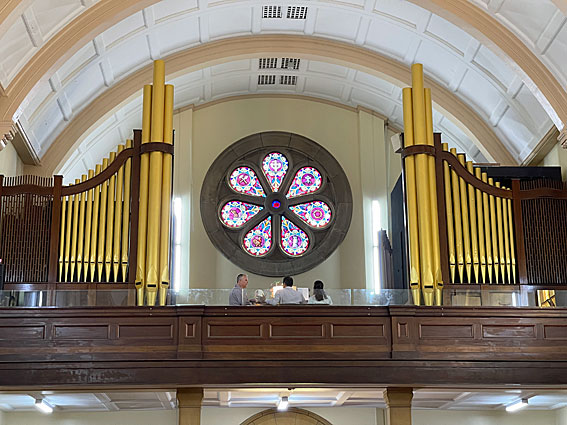

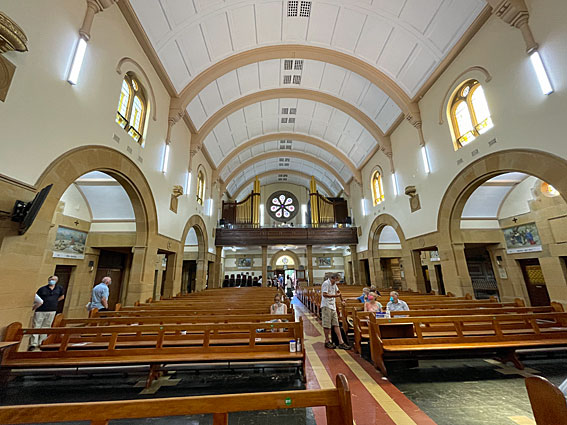
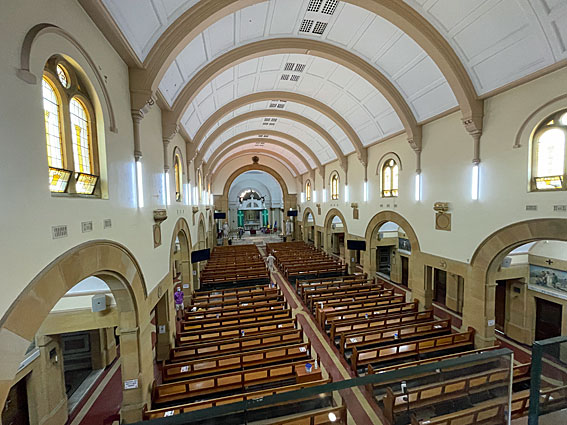
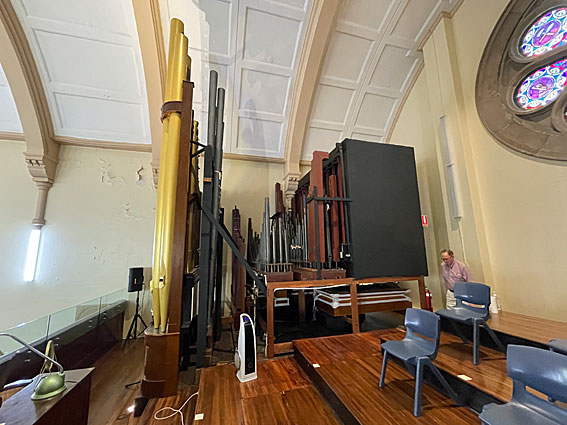
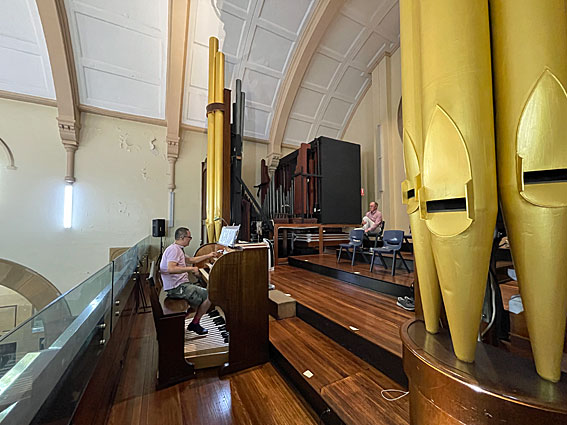
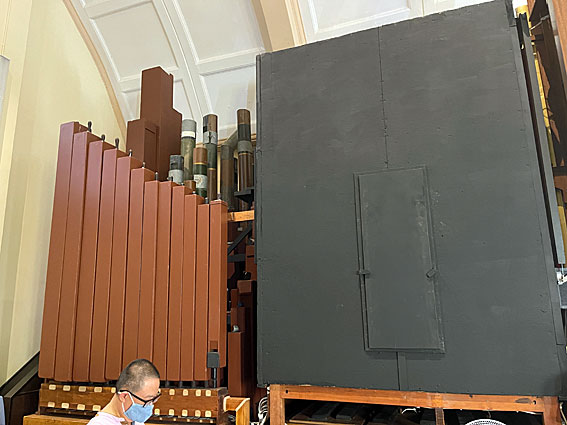
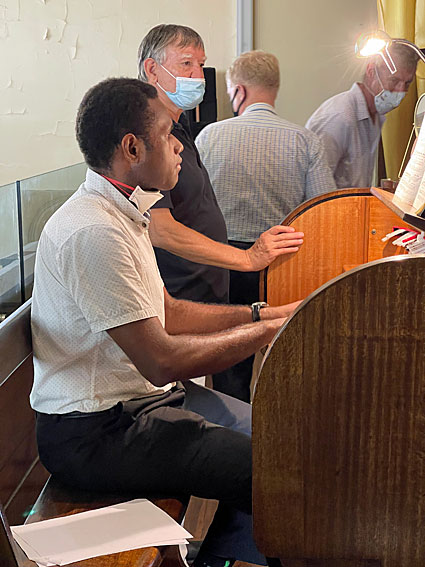
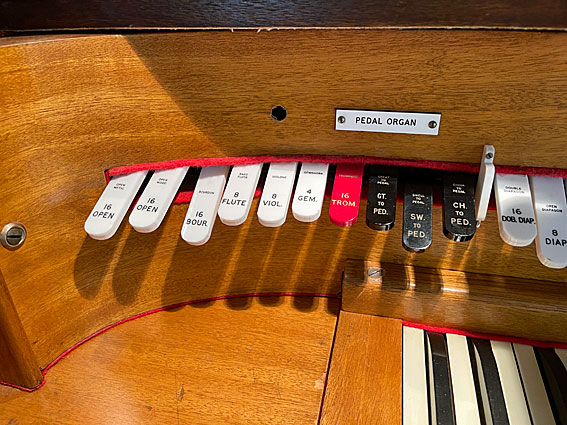
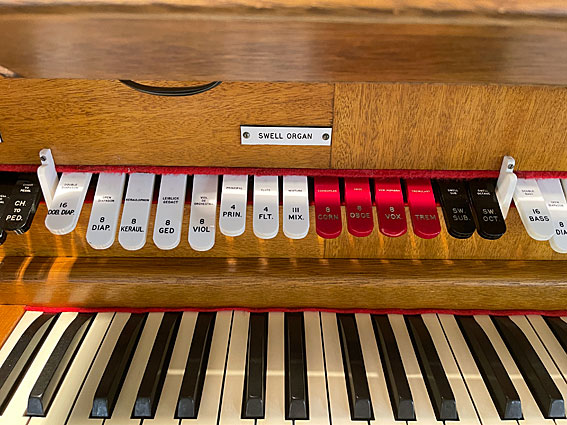
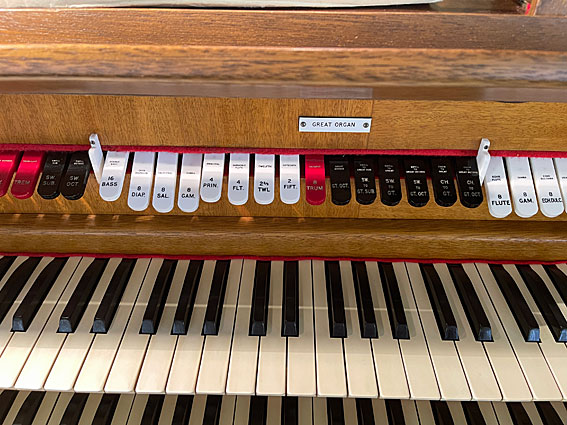
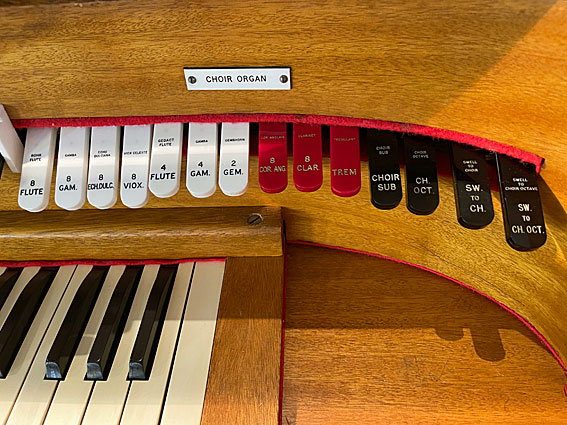
Photos above: Mark Quarmby [26 January 2021]


Photos: Trevor Bunning (Dec 2008)
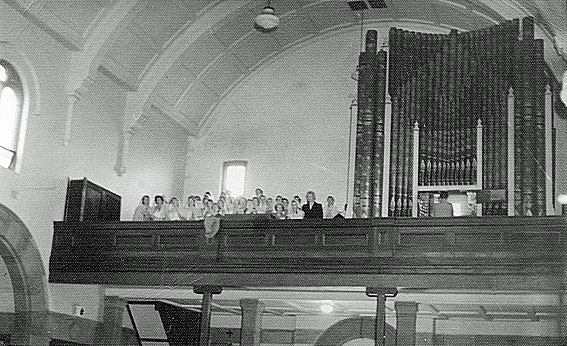
Fred Hawkins writes (March 2009):
I came across this picture and wondered whether it would be of use to the Society. It shows how the Bryceson organ in St Brigid's Church in Marrickville looked during the period of my tenure there which was from about 1943 until the organ was taken out of service for a rebuild in about 1955. The shot is taken from the same perspective as those on your website of the organ after the rebuild and so may fill out the history of this very nice organ. Before the rebuild, it had a hybrid action, mostly tracker but with tubular pneumatic for the Pedal organ and for some of the Swell. Although it was a bit of a beast to play as the action loaded up very heavily under couplers, the combination pedals (of which there were 8) were heavy to operate and very noisy, and the Swell and Choir shutter control was primitive with notched sticks to hold the boxes open, it was nevertheless a very responsive and satisfying instrument and was maintained in fully operational condition.
Fred Hawkins